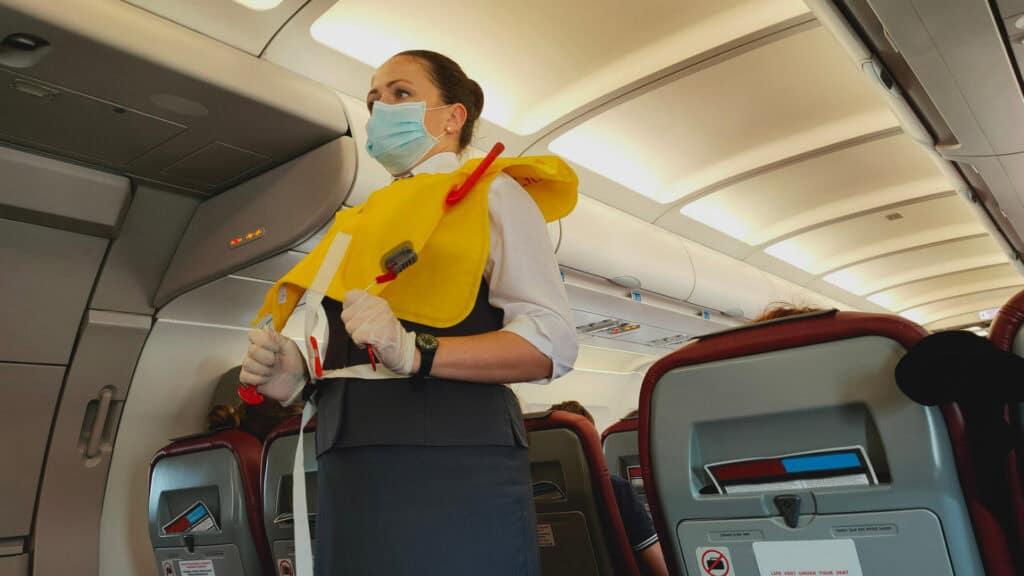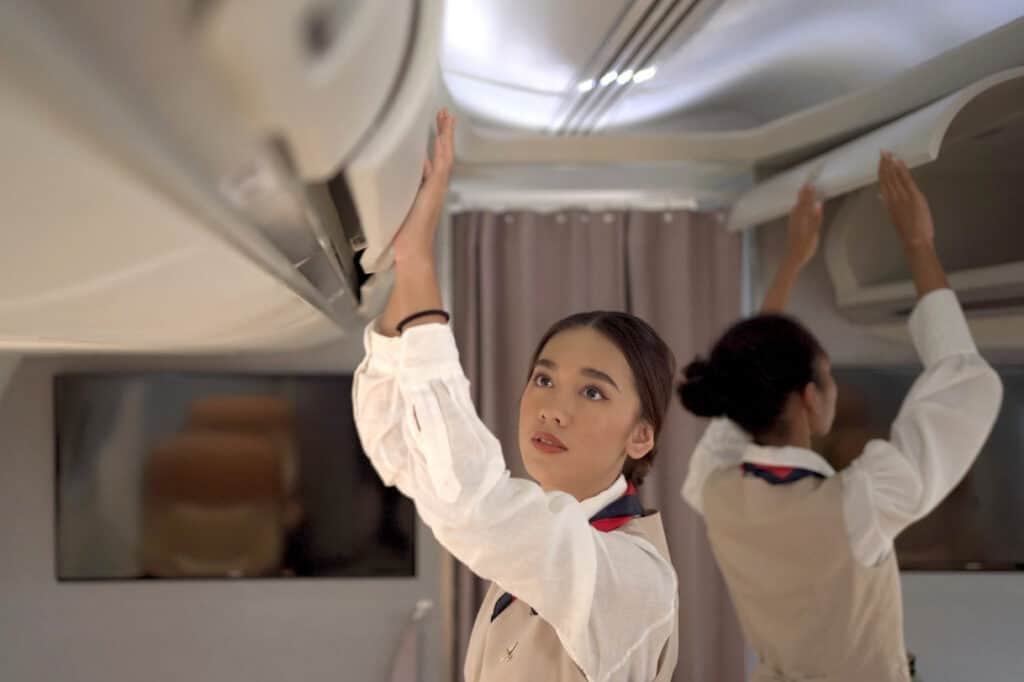Comprehensive cabin safety training is a vital aspect of a flight attendant’s role and responsibilities. Flight attendants are not just there to serve food and drinks; they are the first responders in the sky, responsible for the safety and well-being of passengers.
Table of Contents
They learn to handle everything from minor problems to big emergencies. Their training is all about being prepared for anything. This training equips them with the skills needed to manage challenging situations effectively. Flight attendants learn to manage emergencies, such as medical issues or evacuations.
Being well-trained helps them keep passengers calm and safe during trouble. They need to make quick and intelligent moves. This all comes down to how well someone trains them. Proper training also builds confidence, enabling them to manage their own stress and fear during emergencies.
The safety of many passengers relies on the cabin crew’s readiness and skill. They must understand their tasks. They must be sure of their actions. Therefore, comprehensive cabin safety training is not just a regulatory requirement; it is essential for saving lives.

1. Understanding the Importance of Safety Protocols
Safety protocols are at the core of comprehensive cabin safety training. These protocols cover everything from pre-flight checks to handling inflight emergencies. Flight attendants must be skilled in using safety equipment like fire extinguishers, oxygen masks, and life vests.
Understanding these protocols ensures that flight attendants are prepared for any situation. Training also includes learning how to guide passengers through emergency exits and use escape slides if necessary.
Being well-versed in these protocols means that flight attendants can maintain order and provide clear instructions during an emergency. Following these protocols is essential for a safe and secure flight.
They are the building blocks of keeping everyone protected in the air. When flight attendants follow safety protocols correctly, it significantly reduces the risk of injury or loss of life.

2. Emergency Evacuation Procedures
Emergency evacuation procedures are a critical part of cabin safety training. In the event of a crash landing, fire, or other emergencies, flight attendants must quickly and efficiently evacuate passengers from the aircraft.
This training involves learning how to assess situations rapidly and determine the safest and most effective evacuation routes. Flight attendants practice these scenarios in realistic simulations to prepare them for real-life situations.
They train to manage panic, guide passengers, and ensure everyone evacuates in an orderly manner. The ability to execute an evacuation quickly can mean the difference between life and death.
Proper training ensures that flight attendants are ready to handle these high-pressure situations and take decisive actions. Emergency evacuation procedures are not just about speed; they are also about ensuring that everyone follows the safety guidelines to minimize injuries.
3. Handling Medical Emergencies
Flight attendants are trained to handle various medical emergencies that may arise during a flight. Passengers may experience issues such as heart attacks, allergic reactions, or other medical crises.
Flight attendants learn basic first aid, CPR, and how to use Automated External Defibrillators (AEDs). This training enables them to provide immediate assistance until professional medical help can be accessed.
They also learn to spot signs of medical distress and know what steps to take. Handling medical emergencies also involves coordinating with other crew members and sometimes even medical professionals on board.
Flight attendants must stay calm and focused, ensuring that they provide the right support to passengers in distress. Handling medical emergencies matters a lot for keeping passengers safe and healthy. It’s vital to ensure everyone on board stays well.
4. Fire Safety and Management
Fire safety is another critical area covered in cabin safety training. Fires on board an aircraft can be extremely dangerous, and flight attendants must be trained to handle them effectively.
Learning to use fire extinguishers is part of the training. It’s essential to know the different types of fires. Knowing how to stop them quickly can prevent more damage. Flight attendants learn to spot things that can cause fires.
They also learn how to collaborate effectively when handling fires. Everyone knows their job in a fire. This training is vital for keeping passengers and the plane safe.
5. Managing Unruly Passengers
Managing unruly passengers is a vital part of a flight attendant’s job and takes special training. Passengers may sometimes become disruptive due to stress, intoxication, or other reasons.
Flight attendants are trained to de-escalate these situations calmly and assertively. They train to communicate effectively, calming tense situations with body language and tone of voice.
Training also covers the legal aspects of managing unruly passengers, including when to involve law enforcement. Flight attendants must balance maintaining a peaceful environment and ensuring the safety of all passengers.
Managing unruly passengers is not just about calming them down; it is about protecting the entire cabin from potential threats. Comprehensive training helps flight attendants handle these situations with confidence and professionalism.
6. Security Threats and Hijacking Scenarios
Cabin safety training includes preparing for potential security threats, including hijacking scenarios. Flight attendants are trained to recognize suspicious behavior and manage such threats discreetly and effectively.
This training teaches talking to the cockpit crew and working with other flight attendants. Knowing how to keep everyone safe is crucial. Learning to deal with dangers like hijackings matters a lot.
Flight attendants get self-defense training to help protect everyone. Ensuring passengers’ safety is a significant responsibility. The goal is to neutralize threats without escalating the situation further.
Being prepared for security threats ensures that flight attendants can handle any scenario with the utmost care and professionalism.
7. The Role of Communication Skills in Safety
Communication is a fundamental aspect of cabin safety training. Effective communication is essential for coordinating actions among crew members and informing passengers during emergencies.
Flight attendants are trained to use clear and concise language when giving safety instructions or addressing concerns. They learn how to stay calm and provide reassurances to passengers, even in stressful situations.
Good communication skills are also vital for relaying information to the cockpit crew and coordinating with ground personnel. Training helps flight attendants develop these skills so they can be effective leaders in the cabin.
By mastering communication, they can ensure that all safety protocols are followed and that passengers remain calm and informed.
8. The Psychological Aspect of Safety Training
Safety training is not just about physical skills; it also involves psychological preparation. Flight attendants must be mentally ready to handle high-stress situations and stay calm under pressure.
Their training often includes techniques for managing stress and keeping a sharp mental focus. Being psychologically prepared enables flight attendants to make quick decisions without being overwhelmed by fear or panic.
This aspect of training is crucial because it helps them stay calm and act efficiently in emergencies. The psychological training component ensures that flight attendants are not just physically ready but also mentally strong to face any situation.
It also helps them provide emotional support to passengers, helping to keep the cabin atmosphere stable.

9. Continuous Learning and Recurrent Training
Cabin safety training is not a one-time event but a continuous learning process. Flight attendants must undergo recurrent training to refresh their skills and stay updated on new safety procedures and regulations.
This recurrent training is usually conducted annually and includes both theoretical knowledge and practical exercises. Continuous learning ensures that flight attendants are always prepared for any situation that may arise.
This approach boosts their confidence and keeps their skills sharp. Staying updated on the latest safety protocols and best practices is vital to ensuring top safety standards in aviation. Recurrent training reinforces the importance of safety and keeps flight attendants prepared to handle emergencies effectively.
Thorough safety training is crucial for flight attendants, helping them handle emergencies and keep passengers safe. From understanding safety protocols and managing medical emergencies to handling security threats, this training covers all aspects of inflight safety.
The training also emphasizes the importance of communication skills, psychological readiness, and teamwork. By undergoing rigorous training and continuous learning, flight attendants are equipped to face any challenges that arise during flights.
Efficiently managing emergencies can be life-saving, ensuring everyone on board has a safe flight. Cabin safety training is crucial, forming the foundation of reliable air travel.



